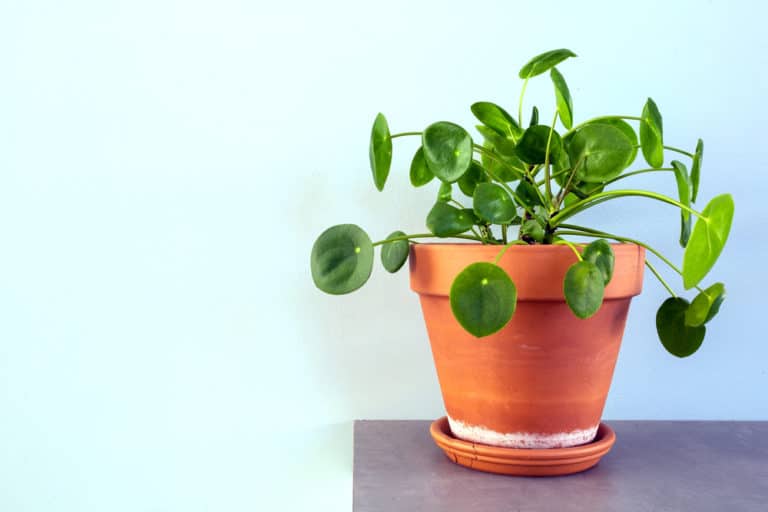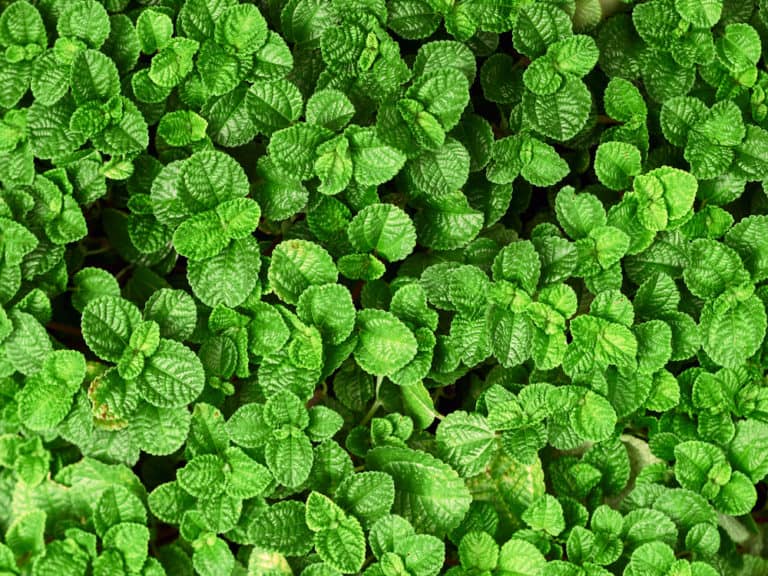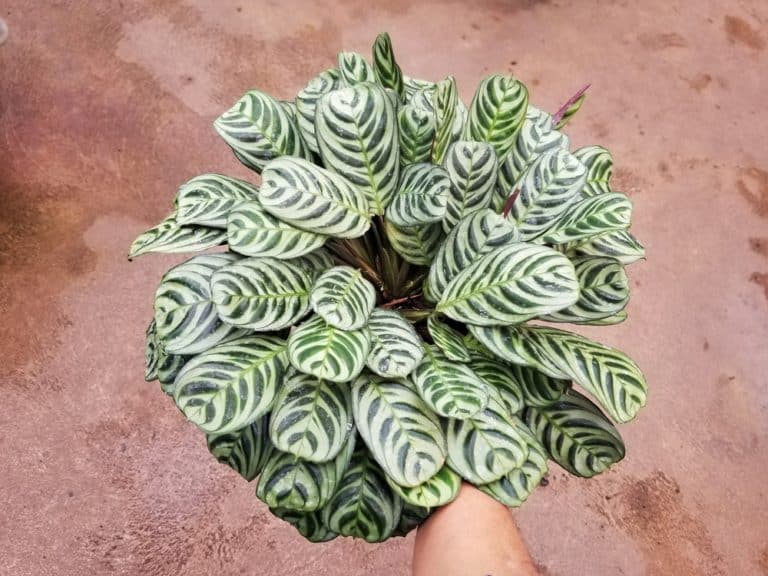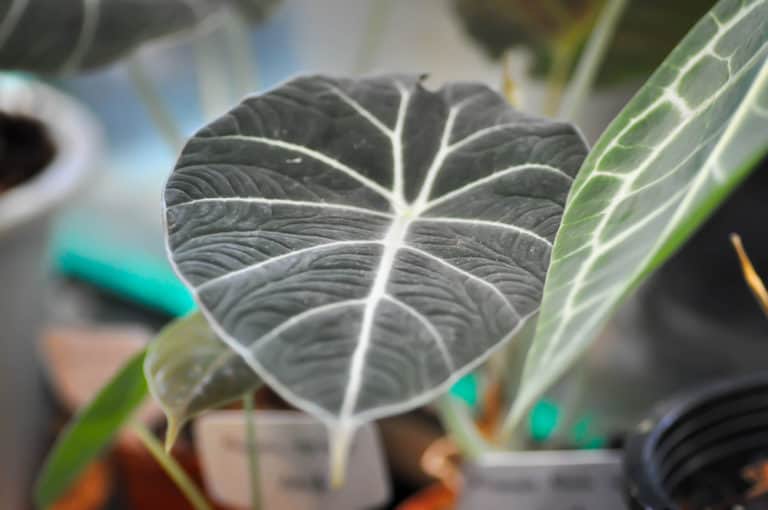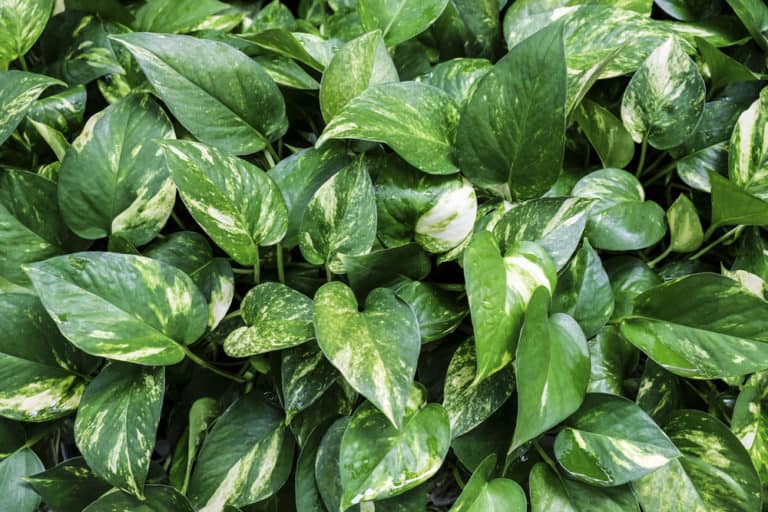Hoya Carnosa Variegata ‘Tricolor’ Care Guide (2024)
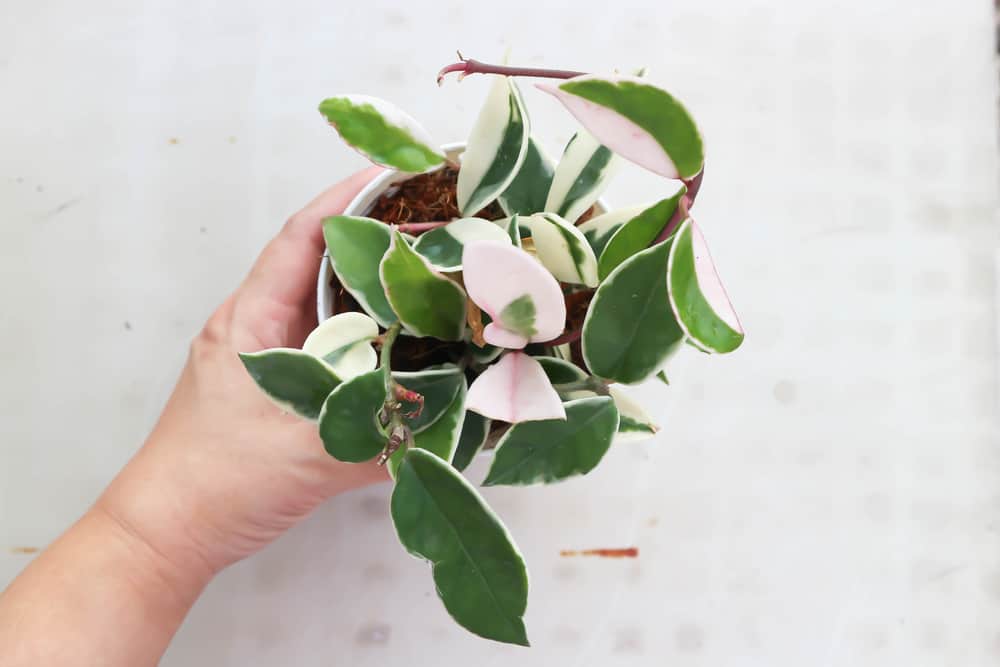
The Hoya carnosa Variegata, commonly known as Hoya Tricolor is a luscious succulent that is of tropical descent. For years, it may have been a staple ornamental plant in many oriental households. With its drought-tolerant characteristic and long-lived foliage, Hoyas are a must-have in your garden and indoor plant collections!
| Scientific Name | Hoya carnosa variegata ‘Tricolor’ |
| Common Name | Wax Plant, Wax vine, Porcelain Flower |
| Light | Bright indirect sunlight |
| Watering | Bi-weekly, water if the top half of the soil is dry |
| Temperature | 70-80 ºF (21- 26°C) |
| Hardiness Zone | USDA hardiness zones 11-12 |
| Humidity | 40-60% |
| Soil Type | Rich in OM and quick-draining |
| Soil pH | pH 6.1-6.5 |
| Fertilizing | A balanced feed twice a week in spring and summer |
| Repotting | When the growth has stopped and roots began to protrude |
| Pruning | Beginning of the growing season |
| Propagation | Stem cuttings |
| Toxicity | Non-toxic |
| Mature Size | Up to 2-3 meters tall |
| Bloom Time | Spring to early summer |
What’s Unique About Hoya Tricolor?
Hoya Tricolor plants are evergreen plants derived from common Carnosa species. They are native to subtropical regions of East Asia but have also been well distributed in the Western pacific. In a tropical rainforest, the plant usually grows as an epiphyte and is thus well acquainted with humid conditions and moderate sunlight.
The Hoya Tricolor plant is adored due to its thick waxy, succulent leaves that have pinkish to off-white variegation. It is often grown in a hanging basket due to its trailing habit. Aside from its lush foliage, the plant would also produce dainty flowers that emit some mildly sweet fragrance.
Hoya Tricolor Care
A specimen that is relatively easy to grow, the Hoya carnosa Variegata care consists of bright, indirect light; a moderate to high humidity, and a rich, well-draining substrate. The plant can thrive well even with a bit of underwatering, making it a low-maintenance addition to your plant collection. To help you be equipped, below are more information on Hoya Tricolor plant care.
Light
The Hoya Tricolor light requirements ranges from bright indirect light to a bit of full sun, but never to the extent that it can ruin the plant’s delicate foliage. Light is an important aspect of growing any variegated specimen, and it is certainly crucial especially if you wish to maintain those beautiful streaks of colors in the leaves.
When grown inside, you can easily attain the Hoya carnosa Variegata light needs by placing it near a window or any spot that receives an ample amount of filtered light. Avoid high light intensity as it can make the leaves scorch and turn yellow.
Watering
As an epiphytic plant, less is more when it comes to Hoya Tricolor watering. The key to avoiding overwatering – which can be fatal to the plant – is by checking first if the top inch of the soil feels completely dry to the touch.
It is ideal to water Hoya carnosa Variegata once every two weeks, but you need to adjust your watering when it is summer as the plant may need more moisture, and then reduce it in the onset of winter. Be mindful of your Hoya tricolor’s watering needs, and do not overdo it as it can lead to root rot.
Temperature
Knowing the right temperature for your houseplants is key to keeping them healthy. Relatively, the Hoya Tricolor temperature range is between 70-80 ºF (21- 26°C). They have a high-temperature tolerance and thrive at USDA hardiness zones 11-12. Avoid temperatures below 50 ºF as this may be damaging to the plant.
The ideal temperature for Hoya carnosa Variegata may be easily attained at home because it usually has a range of 18-24°C. To sum it all up, the plant prefers to be kept warm, but when grown outside, exposure to extreme cold must be avoided to prevent freezing injury to the plant.
Humidity
The Hoya Tricolor humidity requirements range from moderate to high. An indoor humidity level works just fine but you can also adjust air moisture by use of a humidifier or by regular misting here and there. The ideal humidity for Hoya carnosa Variegata is at least 40-60%.
Pro tip: When tending to a tropical houseplant, you may set up a pebble tray filled with water and place it below your potted plant. You can also set up a bigger pebble tray to accommodate more houseplants and that way they sit close to each other, allowing more moisture to saturate the air. .
Soil
The soil for Hoya carnosa Variegata is preferably well-draining but rich with organic matter. This should be able to mimic the kind of soil to which the plant is accustomed in the wild. You can concoct your own Hoya Tricolor soil by mixing an equal proportion of fresh garden soil, coco coir, and compost. OM improves soil nutrients and moisture retention while the coco coir improves texture and drainage.
Moreover, the ph level for Hoya carnosa Variegata is about 6.1 to 6.5, which is moderate to slightly acidic. Note that you can also use a soil mix typically used for orchid plants which you can buy from your local plant market.
Fertilizer
When it comes to Hoya Tricolor fertilizer, you can use a water-soluble with a balanced ratio, but since it is a foliage plant, you may opt to adjust the nitrogen content and make it 2:1:2 or 3:1:2. This fertilizer ratio will make your hoya tricolor happy and thus able to produce healthier shoots.
In applying fertilizer for Hoya carnosa Variegata, dilute to half strength and apply once every two weeks. This may be a bit crucial during the growing season, which usually occurs in summer or spring. There’s no need to apply fertilizer during the winter season.
Potting & Repotting
It’s best to do Hoya Tricolor repotting in the early spring to early summer, but only when you notice that the growth has stopped and that roots are already showing from the base of the plant. Always choose a pot size that is twice of the original container and with sufficient drainage.
When you are repotting Hoya carnosa Variegata, prepare a good quality potting mix, particularly one that is rich in organic matter and has a coarse texture. Fill the new container with half of the substrate and then place the plant in the center. Fill with the remaining soil and water thoroughly.
Pruning
Hoya Tricolor pruning is usually done at least once a year. It’s a good practice to trim off spent foliage and even flowers in order to keep the plant vibrant and healthy-looking. When cutting Hoya carnosa Variegata, trim the vine off about an inch below a node and be sure to snip only those that appear dull and with signs of decay.
Pruning generally keeps the plant healthy and it encourages more formation of new shoots and even flowers. Note that when the plant has determined to flower, floral initials tend to develop faster when pruned. Also, pruning may help prevent the onset of diseases.
Propagation
The easiest and most common way to propagate Hoya carnosa Variegata is through the use of stem cuttings. Do this by finding healthy stems with a few nodes at least 4 to 5 inches long. Use a sterile knife or shears and cut across the stem with a few leaves.
You can easily propagate Hoya carnosa Variegata by either directly planting the cuttings into the soil or by allowing them to sit in a jar of water for long periods of time. Place near a source of bright, indirect light and you can expect some roots to form within 3-4 weeks’ time.
Also, make sure to check out our in-depth Hoya australis lisa plant care guide.
Common Problems of Hoya Tricolor
Most problems with Hoya carnosa Variegata are caused by improper cultural management such as overwatering and underwatering, and overfertilization. These may lead to a number of unappealing symptoms such as blackening of the leaves, leaf-drop, and dieback of stems. Below are the usual Hoya Tricolor problems that you may encounter and the ways you can address them.
Pests
Mealybugs, spider mites, and other sap-sucking bugs may become problematic for your Hoya carnosa Variegata if they are able to proliferate in large numbers. Hence, it pays to regularly check the leaves, nodes, and even the base of the plant where these insects can hide.
Signs of Hoya Tricolor pests include spots, yellowing of the leaves, and dry appearance of the stem, neem oil may be your best natural remedy as to a spray for both the upper and lower surface of the leaves. Also, make it a habit to regularly wipe off the foliage with any specks of dust and secretions such as honeydew from aphids, etc.
Diseases
While the Hoya carnosa Variegata is quite a hardy plant, it can still suffer from bacterial and fungal infections, which are typically aggravated by waterlogging, high temperature, and humidity. For example, botrytis infection which is caused by the fungus Botrytis cinerea, can affect the foliage by covering it with masses of brown to greyish spores, making the leaves spongy to the touch over time.
The most effective way to stop the spread of any existing Hoya Tricolor diseases is by pruning off the infected plant parts by use of sterile shears. Others may opt to use fungicides if the damage to the plant has become too prominent.
Growing Problems
Aside from pests and diseases, growing problems may be attributed to neglect and improper cultural management being observed. For instance, overwatering can create irreversible problems such as root rotting, and overfertilization may lead to poor root structure which can limit nutrient absorption.
It is important to investigate what may be causing the symptom of a sick plant to effectively address it. Regularly check the foliage, and base of the plant for any impending infestation as well as wounds that can become an entry point for infections; avoid overwatering at all costs, and avoid the use of cheap fertilizer that can do more damage than good.
Toxicity of Hoya Tricolor
Hoyas, in general, have no known toxicity to both humans and animals. Similarly, the Hoya carnosa Variegata is not considered toxic to pets and small children. Hence, it may be a relief for plant enthusiasts and parents, especially if they wish to grow the plant indoors. However, one must still be cautious in dealing with any plants as they may still cause certain irritations.
For Humans
Growing Hoya Tricolor plants indoors is considered safe. In fact, the University of Connecticut includes Hoya plants in their list of non-toxic houseplants that you can easily tend to. However, humans – particularly small children – should not ingest any part of the plant as this may still cause adverse reactions.
Symptoms that may arise from ingestion of the plant are vomiting, diarrhea, skin irritation, and nausea. While these are not considered fatal and may not be as alarming as compared plants that actually have some level of toxicity, touching and swallowing any parts of hoya tricolor should be discouraged.
For Pets
While the Hoya Tricolor is not toxic to animals, it should not be ingested by any of your pets as it can still upset their stomach and cause several symptoms such as uncontrollable urine, defecation, and vomiting. Hence, it’s important to remain cautious when you are growing the plant indoors.
Considering the environment from which the plant originates, the epiphytic plant would often compete in the wild for resources, and thus may develop phytochemicals that may be useful for its quest in the tropics. If large portions were ingested, these chemicals may cause a reaction that may be best relieved and addressed in the vet’s office.
Hoya Tricolor Appearance
The Hoya carnosa tricolor is notable for its heavy waxy leaves, and vibrant colors of green, white, and pink. Similar to most hoya plants, the Hoya Tricolor appearance consists of creamy variegation that runs from the center of the leaf up to the margins. Due to its ease of care and hardy characteristic, the plant is a well-loved houseplant for generations.
Foliage
Perhaps it is the foliage of Hoya tricolor plant that may be considered its most covetable feature. The broad and succulent leaves with a stunning mix of deep green and off-white color, surely make the plant a great specimen for potted and hanging plants. Also, its ability to hold water enables it to withstand drought conditions, and thus survive even with limited soil moisture.
Each leaf measures up to 3 inches wide and about 0.8 inches thick. Over time, the leaves would beautifully trail from the hoya tricolor’s pinkish vines and provide an idyllic scenery to any household and tropical garden.
Flowering
The Hoya Tricolor flowering usually occurs in spring to early summer as this is the most favorable time for floral development. The Hoya carnosa Variegata flower comes in clusters of 10 to 30 and is characterized as dainty, star-shaped with tiny hair coverings – which gives it a fuzzy appearance – and has colors that range from off-white to pink.
The blooming period can last up to a couple of weeks and it is easily noticed as the plant eventually emit a sweet smell produced from the flowers’ nectar. The scent is reportedly similar to honey and some even say it is similar to chocolate.
Size and Growth
Hoya Tricolor plants have a relatively fast growth rate. The size of each broad leaf can spread from 3 inches wide and 0.8 inches thick. In the wild, the size of Hoya carnosa can go up to a staggering length of 20 feet. However, in an indoor setting, the length of the vines would only grow up to 6 ft. long, and the plant at about 2-3 meters tall.
Fertilizer application during the growing season can hasten the growth even more along with foliage development, but depending on the fertilizer ratio, high nitrogen content favors more leaf formation. Moreover, pruning the hoya tricolor makes it appear fuller and healthier.
Hoya Tricolor Fragrance
The Hoya Tricolor fragrance mainly comes from the flower cluster that produces sweet-smelling nectar. You’ll know when your Hoya tricolor is in full bloom when it gives off a sweet buttery honey-like scent, and others compare it to that of sweet chocolate.
It’s important to note, however, that there are other smells that you must be wary of. For example, fungal infections and rotting roots can emit unpleasant odors. When you notice any unusual smell coming from your hoya tricolor, be sure to check the plant and see if there’s any sign of a disease that needs to be addressed immediately.
Suggested Uses for Hoya Tricolor
The Hoya Tricolor plant’s trailing habit is suitable for a hanging basket, but it can also be used as a corner specimen for a tropical garden, or a simple pot plant. Yet aside from all the aesthetic features that the plant can offer, you’ll find it both amusing and comforting that this stunning succulent has an air-purifying capacity.
With this, growing the plant indoors provides you the benefit of livening up rather dull spaces and at the same time filters out pollutants from your home. Plus, the non-toxicity makes them a safe accompaniment plant. Hence, adding the Hoya tricolor to your collection is a must!
FAQ
What is Hoya Tricolor?
The Hoya Tricolor is a luscious succulent that is of tropical descent and has developed from the common Carnosa species. For years, it is a staple ornamental plant in many oriental households.
How to identify Hoya Tricolor?
The Hoya Tricolor has a broad set of succulent foliage with stunning variegation of deep green and off-white color, while the stems are pinkish to pale red.
How to care for Hoya Tricolor?
Hoya Tricolor needs an adequate amount of bright filtered light, an organically rich substrate, and a warm humid condition. It’s also important that the right amount of water is given to the plant.
How to grow Hoya Tricolor indoors?
You can grow your Hoya tricolor indoors by placing them near a curtained and east-facing window. Also, maintain a humidity of at least 40-60% and water only when the soil dries completely.
How to grow Hoya Tricolor outdoors?
When growing your Hoya tricolor outside, be sure that the plant receives some afternoon shade and is not exposed to full sun. Water as needed and apply fertilizers once every two weeks.
How fast does Hoya Tricolor grow?
The Hoya tricolor has a fast growth rate and new shoots may arise in just a couple of months. In the wild, it can grow up to 20 feet long.
How tall does Hoya Tricolor grow?
In the wild, the Hoya tricolor can grow up to 20 feet long, but in cultivation, they can grow only up to about 2-3 meters tall.
How to make Hoya Tricolor grow faster?
Hasten the growth of your Hoya tricolor by applying fertilizers with a balanced ratio at least once every two weeks, particularly during the growing season.
How to stake Hoya Tricolor?
Put a stake behind your Hoya tricolor in order to guide it as it trails downward. Tie the plant onto the stake but be sure not to overdo it.
How to pot Hoya Tricolor?
Prepare a fresh potting mix, fill the new container with half of the substrate and then place the plant in the center. Fill with the remaining soil and water thoroughly.
How to revive Hoya Tricolor?
Aside from proper cultural management, pruning off spent foliage, dead flowers, and stems proves, to be the best way to revive a rather dull-looking hoya plant.
Why is my Hoya Tricolor dying?
A dying Hoya tricolor plant may be a sign of infestation or root rotting. Avoid overwatering at all costs and regularly check for signs of a disease or of any feeding insects.
Why is my Hoya Tricolor drooping?
Drooping leaves may be caused by overwatering and underwatering. Be sure to water the plant as needed and repel any insects that may accumulate and feed on the plant.
How cold can Hoya Tricolor tolerate?
Do not let the temperatures go below 50ºF (10ºF) as this may be damaging to the plant. The hoya tricolor plant is quite susceptible to freezing injury so be sure to avoid extreme cold.
How to get rid of pests on Hoya Tricolor?
A natural way to get rid of pests is the use of horticultural oils like neem oil. You can spray it on the leaves or use it to wipe the surface.
Is Hoya Tricolor toxic to cats?
No. The Hoya Tricolor has no known toxicity to cats and is thus safe to grow indoors. However, the plant should not be ingested as it may still cause some reactions.
Is Hoya Tricolor toxic to dogs?
No. The Hoya Tricolor has no known toxicity to dogs and is therefore considered a safe plant to have around. However, the plant should not be ingested as it may still cause adverse reactions.
Is Hoya Tricolor toxic to children?
No. The Hoya Tricolor plant is not considered toxic, but it may still cause symptoms such as vomiting, diarrhea, and nausea, especially in small children.
Is Hoya Tricolor toxic to humans?
No. The Hoya Tricolor is not considered toxic to humans, but ingesting it should still be prevented as it may still cause adverse reactions to certain individuals.
Does Hoya Tricolor have a scent?
Yes. The Hoya carnosa Variegata produces small clusters of flowers that have some sweet smell and are reportedly similar to that of honey and chocolate.

